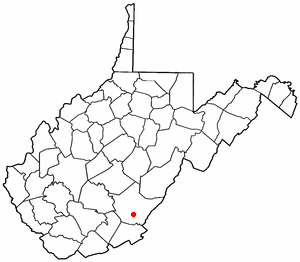Lewisburg, West Virginia
|
|
Lewisburg is a city located in Greenbrier County, West Virginia. As of the 2000 census, the city had a total population of 3,624. It is the county seat of Greenbrier CountyTemplate:GR.
| Contents |
Geography
Lewisburg is located at 37°48'15" North, 80°26'25" West (37.804076, -80.440408)Template:GR.
According to the United States Census Bureau, the city has a total area of 9.9 km² (3.8 mi²). 9.9 km² (3.8 mi²) of it is land and none of the area is covered with water.
Demographics
As of the censusTemplate:GR of 2000, there are 3,624 people, 1,746 households, and 1,000 families residing in the city. The population density is 367.3/km² (951.0/mi²). There are 1,929 housing units at an average density of 195.5/km² (506.2/mi²). The racial makeup of the city is 90.73% White, 6.68% African American, 0.44% Native American, 0.52% Asian, 0.00% Pacific Islander, 0.36% from other races, and 1.27% from two or more races. 0.66% of the population are Hispanic or Latino of any race.
There are 1,746 households out of which 20.5% have children under the age of 18 living with them, 46.6% are married couples living together, 8.6% have a female householder with no husband present, and 42.7% are non-families. 38.5% of all households are made up of individuals and 19.4% have someone living alone who is 65 years of age or older. The average household size is 2.04 and the average family size is 2.69.
In the city the population is spread out with 17.8% under the age of 18, 6.8% from 18 to 24, 22.8% from 25 to 44, 28.3% from 45 to 64, and 24.2% who are 65 years of age or older. The median age is 47 years. For every 100 females there are 79.1 males. For every 100 females age 18 and over, there are 74.3 males.
The median income for a household in the city is $27,857, and the median income for a family is $42,940. Males have a median income of $38,056 versus $21,386 for females. The per capita income for the city is $22,139. 19.6% of the population and 12.4% of families are below the poverty line. Out of the total population, 21.2% of those under the age of 18 and 16.6% of those 65 and older are living below the poverty line.
History
Lewisburg is named after Andrew Lewis. In 1751 Lewis, as a young surveyor, established a camp near the spring behind the present courthouse. This spring has been known as the Lewis Spring since that time. During Pontiac's Rebellion in 1763, American Indians completely destroyed two of the early settlements in Greenbrier County, killing the men and carrying off the women and children. This raid virtually eliminated all of the earliest settlers in the county. The American Indians were primarily Shawnees, and (according to undocumented tradition) were led by the famous leader Cornstalk.
By 1770 a fortified encampment called Fort Savannah was established at the Lewis Spring. In 1774, Governor Dunmore of Virginia instructed then-Colonel Andrew Lewis to gather "willing and able men" to go to the great Kanawha River and stand against the American Indian forces that were attacking the Greenbrier Valley. In what became known as Lord Dunmore's War, over 1,490 men were assembled, including Lewis’s brother Charles, and consisting of what history books refer to as one of the most remarkable assemblages of frontier leaders in American history. Thirteen were men of political and military distinction. Lewis's army marched up the Kanawha River to the Ohio River, where they successfully fought the Battle of Point Pleasant against Cornstalk's Shawnees.
Lewisburg was formally established in 1782 by an act of the Virginia General Assembly.
To accommodate Virginians west of the mountains, several Virginia courts sat in Lewisburg, where Patrick Henry once successfully defended a client accused of murder. The town and the surrounding farms prospered and a number of spas and resort hotels were established at some of the outlying mineral springs.
During the Civil War a number of engagements were fought in and around Lewisburg. Several of the present buildings in town were used as a hospitals and barracks by both sides in this conflict, and bullet marks can still be seen in some today. The Virginia Supreme Court library, located in Lewisburg and now the Greenbrier County Library, was used as a hospital and has preserved a section of wall with soldiers' graffiti.
Today Lewisburg is home to the West Virginia School of Osteopathic Medicine, one of 19 osteopathic medical schools in the United States.
In 1978, a 236-acre area in the heart of Lewisburg was designated a National Register Historic District.
External links
- http://www.wvsom.edu/ West Virginia School of Osteopathic Medicine

